Port of Spain Bioblitz and Nature Fair 2016
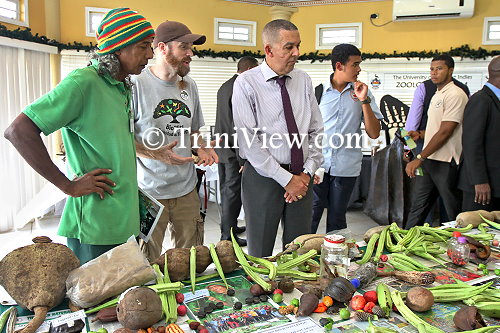
(3rd from left)…His Excellency Anthony Carmona during a brief tour at the base camp
From Friday 4th to Sunday 6th November, 2016, the Royal Botanic Gardens was the base camp for the highly informative fifth annual “Port of Spain BioBlitz and Nature Fair”. Hosted by the Trinidad & Tobago Field Naturalists Club (TTFNC) and the University of the West Indies Zoology Museum, the occasion included over twenty organizations, NGO and charities. On the opening day His Excellency Anthony Thomas Aquinas Carmona and Minister of Agriculture, Land and Fisheries, Clarence Rambharat visited and made the rounds through the various tents.
According to Mike Rutherford, the curator of the UWI Zoology Museum and the organiser of this event, a BioBlitz is an event in which teams of experts, enthusiasts, volunteers and naturalists work together in one place and over a twenty-four period, try to find, identify and document as many different species of plants, birds, mammals, reptiles, fish, marine invertebrates, terrestrial vertebrates, bugs, microbes and single-celled organisms as possible. Public participation is encouraged through various activities with the goal of getting people interested in biodiversity and wildlife.
Five years ago, from 17th to 18th November, 2012, Tucker Valley, Chaguaramas was the base camp for the first ever BioBlitz in Trinidad and Tobago and the Caribbean. This event has since then been hosted annually throughout Trinidad and Tobago in the areas of Arima Valley, the Nariva Swamp, Charlotteville, Tobago and the Botanic Gardens, Port of Spain respectively.
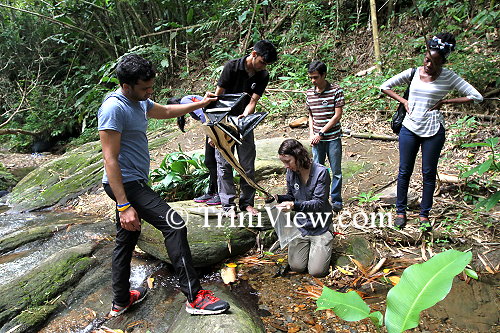
The Aquatic group surveying the Fondes Amandes river, St. Ann’s
Rutherford explained that they have been expanding what they are covering every year and increasing the number of techniques they use as well as the number of enthusiasts who get involved. Annually, they do a public outreach which is usually one morning or one afternoon of activities, doing the survey on Saturday and inviting the public to participate on Sunday. This year, they expanded the event and had three days of public outreach with the BioBlitz taking part in the middle. Not getting the kind of public attendance they had hoped for from past events held in remote areas, he felt that the Botanic Gardens, Port of Spain, would be ideally suited for this year’s affair. Hosting the event at this venue this year also coincided with the celebration of the Port of Spain based TTFNC’s 125th anniversary.
Rutherford shared that some of the areas of this year’s survey included the hills of St. Ann’s peak, down to the coast at Invaders Bay and the top edge of Caroni. As per the Bioblitz tradition, wherever their base camp is, they organise a five kilometre wide circle and everything that comes within that radius is surveyed. He said that sometimes this work is easy, as a lot of the experts can easily identify their subjects; but for others like the botanists whose job is quite demanding based on sheer numbers and the zoologist who has the hard job of finding their subjects, it’s a bit trickier.
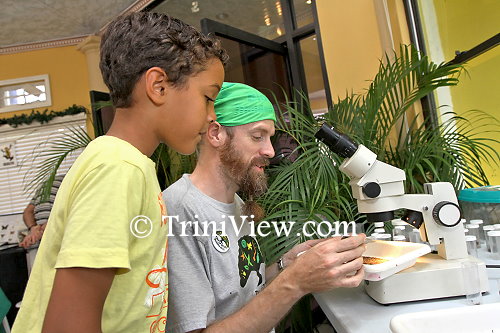
A young curious onlooker observes how Mike Rutherford examines a specimen
Although most of their findings are identified in the field, some specimen, usually the smaller ones, must be examined under a microscope to get proper identification and what cannot be easily identified, will be added to the total count as species A or B. Sometimes a collection of these species is added to the Zoology Museum and will be researched deeper in the weeks and months after the event. Rutherford disclosed that new species have been discovered and recorded over the past few years. For instance, there are records of the first of a type of spider for Trinidad; the first of a particular species of bats found last year in Tobago; and in the Nariva Swamp, a new type of frog for Trinidad.
With the challenges of tight schedules and a limited budget, Rutherford explained that they don’t conduct outreach as much as they would like to. He feels assured that some of the ways these challenges can be tackled is with bigger funding on a long-term basis for proper training, equipment, promotional materials, accommodations, and food and drinks for the volunteers when needed.
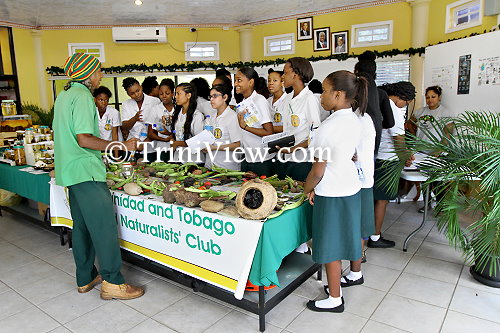
Students from St. Francois Girls College, Belmont check out a variety of vegetables and fruits
Some of the other representatives of the BioBlitz also shared some information about their organisations and the work they do.
Nikkolai Dubisson, a student at UTT Marine Sciences campus, Chaguaramas and a member of a student group called the Marine Mantas, explained they have been doing mobile awareness campaigns in schools, malls and events such as this to educate the public on how to conserve and protect the marine life in our local waters. He thinks that it is up to all of us to have a positive impact on the environment either by working together with organisations as a community based effort, or simply by recycling plastics. He emphasised that people should start helping organisations work with other organizations to recycle or promote sustainable developments of the resources in the ecosystem.”
Shaun de Luna from Wa Samaki Ecosystems/Permaculture Trinidad expressed that they are involved in permaculture which is a mindful design and maintenance of an agriculturally productive ecosystem with the resilience and stability of a natural ecosystem. “Understanding how nature works, how forests work and how building a forest that is agriculturally productive instead of making something waste, limiting waste and understanding what could be done before it becomes waste,” is part of the process of permaculture. The name Wa samaki, he said, is Swahili that means “from the fish”. The farm started as a fish farm selling and exporting tropical fish but the market slowed down and they went into heliconia production which is the main plant on the farm, along with root crops like dasheen, tania, eddoes and cassava. He stressed that no synthetic fertilizers, chemicals or any pesticides are used on the produce; it is strictly organic.
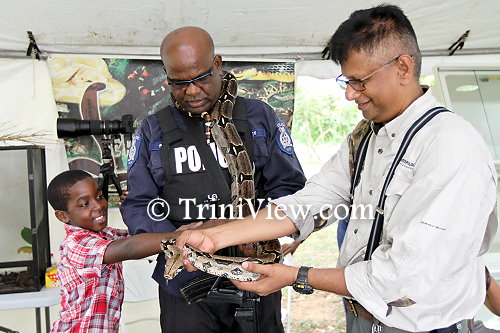
(R): Saiyaad Ali, manager of Serpentarium TT shows off one of his snakes
Serpentarium and the Reptile Conservation Centre of Trinidad and Tobago attracted many curious visitors to their booth where live snakes of various sizes, lizards and caiman were on display. Saiyaad Ali, manager of the centre, said that their focus is on wildlife education, rehabilitation, rescue, and relocation. They visit schools throughout Trinidad and Tobago and try to share the knowledge on how to protect wildlife, some of which are newly discovered right here in Trinidad, and how to handle encounters. He also shared that they have been involved with the BioBlitz for four years now. With twenty-five years of experience behind him, Ali still sees this work as an opportunity to learn. His entire team, he says, is also learning not only about snakes but about plant life, aquatic life and insect life. His message to the public: “Do things in a way that we can all cohabitate; be friendlier to animal life.”
Lanya Fanovich and her team from Environmental Research Institute Charlotteville, Tobago, have also been actively involved with the BioBlitz since last year, particularly the marine surveys. This group is heavily involved in environmental monitoring, community engagements, supporting ecotourism, and sustainable tourism initiatives, particularly in north-east Tobago with much emphasis on capacity building of community members. The BioBlitz, she said, is a good way to get the public involved to become aware. Fanovich further stated that a lot of the information that students get at school is very generic and does not have practical application that focuses on Trinidad and Tobago. According to Fanovich, “If [people] are aware of exactly what is going on in Trinidad and Tobago, how they impact upon it and how that environment impacts on them, this would further empower the younger generations to have a greater stand in terms of environmental issues within their communities, within their cities and island.”
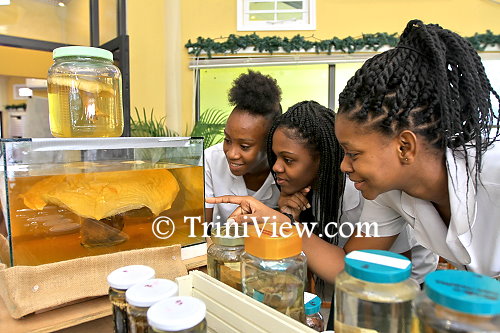
Students from St. Francois Girls College Belmont observe some of the mushrooms on display
Conservation Officer Kimberly Chu Foon of the ASA Wright Nature Centre shared her enthusiasm saying, “I was happy to hear that this year’s event was held in Port of Spain. We call it the ‘concrete jungle’ and not a lot of people are aware of what there is around them.” This group has been participating in the BioBlitz events throughout the years. According to Chu Foon, their mission is to protect a part of the Arima Valley in its natural state for the purpose of conservation, education and research. They have a strong educational outreach programme called the Valley Schools Outreach programme which targets about twenty-one different schools in the Arima valley. Chu Foon expressed, “I think so much of the learning and teachings is about providing kids with information and having them pass an exam as opposed to educating them.” She thinks that a good way for children to be educated is to visit some of these sites and to become part of events like the BioBlitz. “Carry them to the Asa Wright Nature Centre and let them see as opposed to just reading in a notebook,” Chu Foon advised.
The Turtle Village Trust of Trinidad and Tobago research manager, Kathryn Audroing said this was the group’s first time at the BioBlitz fair and they were very excited to be there; “It’s been very good and we’ve gotten a lot of feedback from the public. We have enjoyed the experience.” The Turtle Village Trust is in all the coastal communities of Trinidad and Tobago. They partner with about twenty community groups around Trinidad and Tobago where they do sea turtle conservation and research. They have also been partnering with the Zoology Museum for several years in some of the educational work they have done. Part of what they do also includes looking at the nesting beaches of sea turtles, primarily the leather back beaches. They also monitor the population of the nesting leather backs as well as some of the other species as there are five species that nest and inhabit our waters.
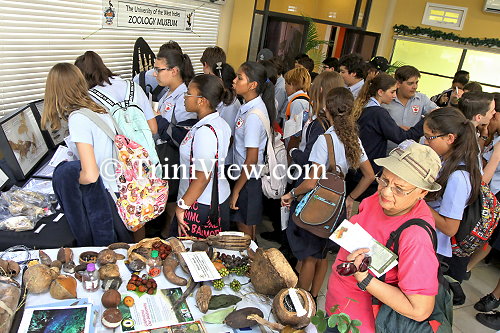
Students of the Maple Leaf International School checking different species on display from UWI’s zoology museum
Elliott Petkovic who is presently here in Trinidad to further his studies represented the Trinibats, a conservation and research NGO organisation. Petkovic declared that they had a fantastic turnout this year with around twenty volunteers. They had a session of bat mist netting on the Friday evening in the Botanical Gardens. In this session, there was one huge net set up called the triple high and two other ground nets which they checked every fifteen minutes. When the bats are caught, they are untangled out of the nets, weighed, measured, their health checked, and any other information that can help identify the species is ascertained. In total, they caught around fifty-five bats which, according to Petkovic, is good for a city park. Inclusive in their count was a rare vampire bat which feeds on the blood of birds. Bats he said, are often misunderstood creatures. He advised, if people have a problem with bats in their homes to contact them to rehouse the bats instead of destroying them.
Jeffrey Wong Sang led the mushroom group on behalf of the TTFNC of which he has been a member since 2013 after the first BioBlitz. Wong Sang has been doing the mushroom count for the BioBlitz every year for the past four years. Sang intimated that his mission is to teach the public, especially the children in schools about the biodiversity of mushrooms and for them to see the beauty of our local, wild mushrooms. He disclosed that, through his own research, there are over five thousand specimens. Wong Sang has been preserving the mushroom specimens in alcohol which he says is not done in any part of the world. He expressed although he is proud to be with Naturalists, he needs for his own group to get the word out, especially to the schools.
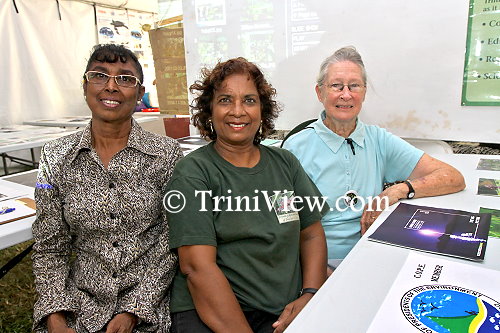
Members of Friends of Botanic Gardens, Trinidad and Tobago
Akilah Jaramogi of the Fondes Amandes Community Reforestation project declared their project is mainly about environmental conservation addressing environmental and social issues within the Fondes Amandes Watershed. Their work also takes them outside Fondes Amandes where environmental practices are shared. She expressed her concerns about the environment saying, “We are part of the environment, we contribute to the environment, we depend strongly on the environment; we can make a difference. For me, the biggest stress I have around the environment is environmental sanitation. I wish people can change their pattern as to the way how they deal with their waste and the way how they treat their environment…recycle, find a bin.” Overall, Jaramogi declared that it was a well spent three days at the Botanic Gardens and she looks forward to joining them for the next BioBlitz.
Friends of Botanic Gardens secretary, Pat Mc Gaw, explained that their role is to take GPS measurements, enter them into a database with all the information like the scientific names, the family names, genus, species, and other general plant information, inclusive of a photograph of the plant. She shared that when the BioBlitz was first suggested, they went to the Council of Presidents of the Environment (COPE), an umbrella body of about twelve to fourteen environmental organisations of which they are a member. According to Mc Gaw, they have a tremendous resource of expertise in all the different environmental fields. About nine or ten members of COPE were involved in this year’s BioBlitz, she said. Mc Gaw also expressed that she thought it was an excellent initiative because it gave COPE the opportunity to highlight the various interest of the organisations within COPE and gave the COPE organisaation a chance to show their strengths and their uses.
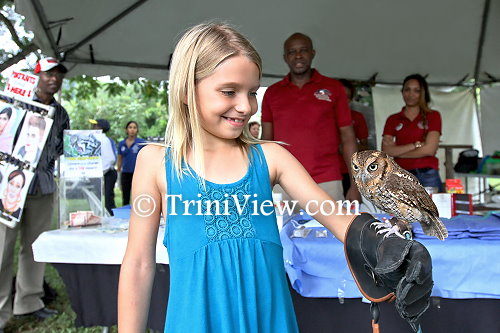
A young visitor admires one of the owls at the El Socorro Centre for Wildlife Conservation booth
Representing the El Scorro Centre for Wildlife Conservation was director and co-founder, Ricardo Meade. Their mission is to conserve wildlife through education, rehabilitation, and wildlife propagation. They were trained by the International Wildlife Rehabilitation Council in basic wildlife rehabilitation, as well as in parasitology, pain and wound management, nutrient fluid therapy among other things. They also have visiting veterinarians who do the surgical and clinical aspects. Concerned about the rate of animal extinction, Meade highlighted that animals such as the red brocket deer, the ocelot, the white-tailed deer which was introduced after the loss of the red brocket deer, and the collared peccary which have all been wiped out by humans in the past fifty years or so. Meade noted that efforts of conservation have had a few setbacks as in Trinidad, for example, the black belly whistling duck, which was reintroduced, are once again being wiped out. Meade’s message to the public is that with appreciation of our environment will come prosperity and other wonderful benefits for us all.
The aquatic group was coordinated by Dr. Amy Deacon from the department of Life Sciences, UWI. She declared that they have a great team which consists of herself, Ryan Mohammed who is a marine and a fish expert, and students who have volunteered. She shared they have had some great finds over the years. In Charlotteville, they found eels and here in Trinidad they found liberty mollies which was an unexpected discovery. Other creatures of interest they look for in the rivers are crabs and the larvae of damselflies and dragonflies. The zangee, she said, is one specie that people seem to be afraid of. It is not a snake and it is not an eel; it is a very long and harmless fish that looks a bit like a snake. She expressed that people are not aware of how many different species are under their feet in the rivers. She advised that people keep in mind that they share those habitats with other creatures and should develop better awareness of their impact on the environment.
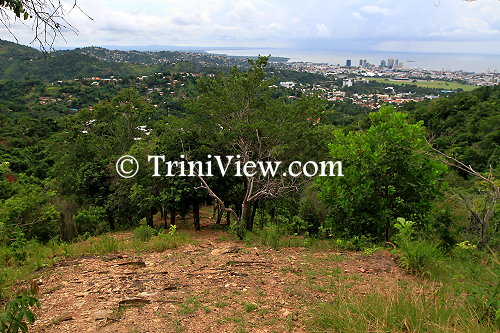
A nature trail up in the St. Ann’s hills
Founded in 1891, this year marked one hundred and twenty-five years since the Trinidad and Tobago Field Naturalists Club has been in existence. The club hosted several events in celebration of its progress throughout the years. Secretary of the club, Dr. Amy Deacon chatted lightly about the club saying, “We are really excited about reaching this milestone. The BioBlitz is just one of the events we’ve had to celebrate this anniversary. It was sort of the pinnacle of our events.” Over the years, they have made some significant discoveries. Some of the founders of the club were the first people to discover certain species and several members have described behaviours in particular species that had never been observed before. Mr. Guppy, who discovered the guppy, was also a member of the club. Another significant change that has taken place is their annual journal titled The Living World which is now available online.

Head of UWI’s Department of Life Sciences, microbiologist Dr. Adesh Ramsubhag
This year was the first time a section on microorganisms in the BioBlitz was introduced. Head of UWI’s Department of Life Sciences, microbiologist Dr. Adesh Ramsubhag shared some information on microorganisms saying, “Microbes comprise of the greatest source of biological diversity on earth. When you talk about diversity of animal species, plant species, insect species, you might run into hundreds of thousands; but when we talk about diversity in microbiology, we are talking about species diversity theoretically in the millions.” According to Ramsubhag, being in a tropical, moist environment, there is absolutely no comparison in the level of biodiversity that has been described and characterised in temperate regions as compared to what we have here. UWI’s Department of Life Sciences continues to focus on promoting microorganisms and garnering wider appreciation for the importance of these organisms. “Events such as this can be one of the strategies that might help in promoting biodiversity, particularly within the school system,” says Ramsubhag.
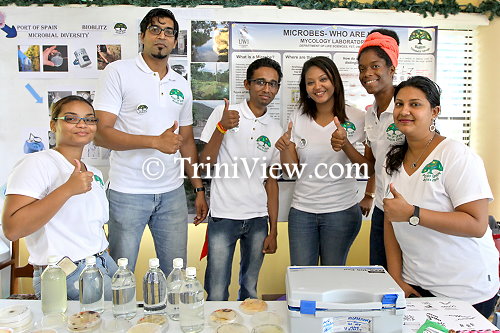
First timers in the BioBlitz, the UWI microbiology group
Akilah Stewart, postgraduate student from The UWI microbiology group shared that, “Microbiological work is not often done within a twenty-four hour period and has not therefore been a part of the BioBlitz in the past. This year, we organised in advance collecting the samples one week prior to the event to be able to have organisms to show the group on the day of the BioBlitz.” According to Stewart, most macrofauna and plants can be seen with the naked eye, but when it involves microbiology, one has to use microscopes. Further, one often has to culture—grow using specialised conditions—the organisms. Stewart’s parting words: “We’ve seen from the BioBlitz how diverse Port of Spain is. While it is very typical to see litter and pollution in the areas we surveyed, all organisms need to co-exist with humans and a big part of that process involves us really considering our environment and realising that we share this space with other organisms. Therefore, we really need to improve on our awareness of how we impact our environment and how we could improve the landscape for all.”
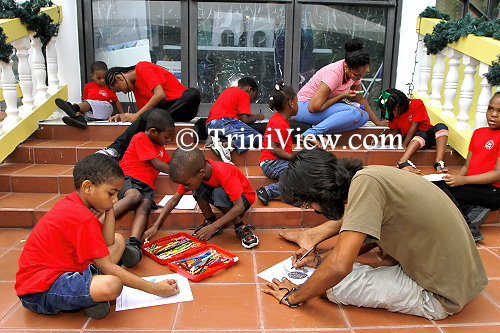
Shaun de Luna and some of the kids from the Marguerite Educational Centre having fun on the opening day
The Botanic Gardens, for those three days was a massive, open classroom. There was something of value for everyone to learn. Representatives of the various organisations were quite professional and very helpful in providing relevant information when needed. Both children and adults were also encouraged to participate in various activities for a better understanding and appreciation of biodiversity and wildlife.
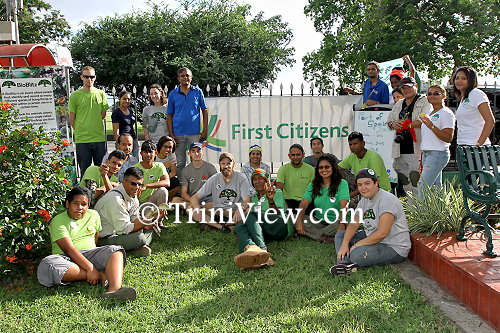
Representatives from some of the groups
The participating organisations included the Council of Presidents of the Environment, Sustain T&T, Fondes Amandes Community Reforestation Project, ASA Wright Nature Centre, Turtle Village Trust, Nature Seekers, Caribbean Youth and Environmental Network, T&T Orchid Society, Pointe-à-Pierre Wild Fowl Trust, Institute of Marine Affairs, Serpentarium, Environmental Policy and Planning Division, Trinibats, T&T Eco Divers, UWI Biological Society, El Socorro Centre for Wildlife Conservation, Caribbean Permaculture Consultants Ltd. – Wa Samaki Ecosystems, Friends of Botanic Gardens, Environmental Research Institute Charlotteville, Tobago, UTT Marine Sciences Unit, Paria Springs Tours, Environmental Management Authority, Erasmus Mundus Alumni Association, National Herbarium of T&T, Water aCCSIS (Sustainable Water Management under Climate Change in Small Island States of the Caribbean), and AquaTT (Aquaculture Association of Trinidad & Tobago).
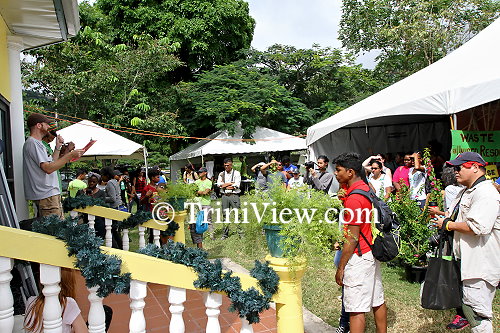
Mike Rutherford announces the results to the crowd
Around 1:30 p.m. on Sunday, Rutherford invited all present to gather for the results. He also took the opportunity to thank everyone for their generous support that helped make the event possible, in particular, their main sponsor First Citizens who have been supporting the Bioblitz every year. Other sponsors included Atlantic and Bermudez who donated snacks.
The final total count was seven hundred and thirty species which included 156 vertebrates, 245 invertebrates, 248 plants, 33 macrofungi, 20 species of bacteria and 28 species of microfungus.
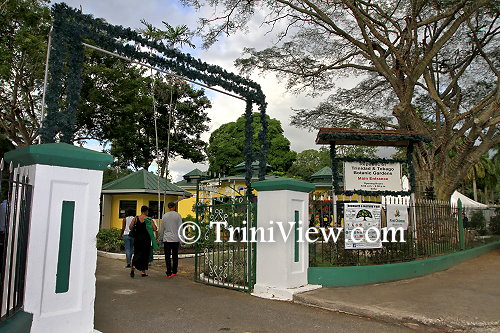
Patrons arriving for the Green Screen Environmental Film Festival outdoor screening
The occasion ended with a series of short films and a feature documentary titled Daughter of the Lake by the Green Screen Environmental Film Festival.
Port of Spain Bioblitz and Nature Fair 2016 in pictures:
www.triniview.com/gallery/main.php?g2_itemId=863707